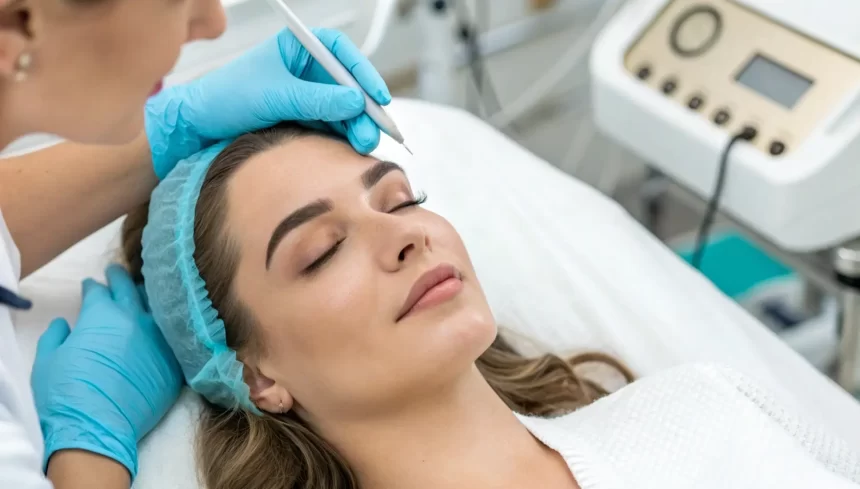Blepharoplasty is a popular cosmetic surgery procedure in the United States. If you feel that your eyes look tired or if your drooping eyelids are narrowing your field of vision, eyelid surgery is a good option. Although the surgery is generally safe, it does carry some risks. Fortunately, many health insurance plans, including some health insurance policies, may cover the procedure if it’s deemed medically necessary.
- What is blepharoplasty?
- Why Do People Get Blepharoplasty?
- Can other cosmetic surgery be performed along with Blepharoplasty?
- Who is blepharoplasty (eyelid surgery) good for?
- The Aesthetic and Medical Benefits of Blepharoplasty
- What are the steps involved in blepharoplasty?
- What to expect?
- Blepharoplasty Recovery and Aftercare
- Top FAQs About Blepharoplasty
- Cosmetic vs. Medical Blepharoplasty
- How much does blepharoplasty cost in the United States?
- How to prepare for blepharoplasty?
- Risks and Benefits
- Choosing the Right Surgeon
- Alternative Treatments to Blepharoplasty
- Conclusion
What is blepharoplasty?
Simply put, it is surgery to improve the appearance or function of the eyelids. Depending on your condition, it can be performed on the upper eyelids, lower eyelids, or both. The procedure removes or repositions excess skin, fat, and sometimes muscle to give you a more youthful, awake appearance. For some, it is cosmetic. For others, it is necessary to correct drooping eyelids that impair vision.
Why Do People Get Blepharoplasty?
There are two main reasons people opt for eyelid surgery:
Cosmetic Reasons:
- To reduce puffiness and under-eye bags.
- To get rid of saggy skin or wrinkles around the eyes.
- To create a refreshed and younger appearance.
Medical Reasons:
- To improve peripheral vision obstructed by drooping eyelids.
- To address discomfort caused by excess skin.
Can other cosmetic surgery be performed along with Blepharoplasty?
Yes, in some cases, other cosmetic surgeries can be performed alongside blepharoplasty. This depends on individual circumstances and beauty goals. Some common procedures that may be done together with blepharoplasty include:
Facelift: For rejuvenating and tightening the skin of the face.
Rhinoplasty (Nose surgery): To reshape the nose and improve facial balance.
Eyebrow lift: To raise the eyebrows and eliminate forehead wrinkles.
Botox or filler injections: To reduce wrinkles and restore volume to the face.
Before deciding to undergo multiple surgeries at once, it’s important to consult with your surgeon to ensure safety and to discuss your expected results.
Who is blepharoplasty (eyelid surgery) good for?
For people over 30 years old. They should be in good health and have no other eye diseases. Tell your doctor if you have any of the following conditions:
- Eye diseases such as dry eyes, retinal detachment, glaucoma
- Thyroid disorders, such as hypothyroidism, hyperthyroidism
- Cardiovascular diseases, high blood pressure or other circulatory disorders
- Diabetes
The Aesthetic and Medical Benefits of Blepharoplasty
Blepharoplasty has significant benefits for appearance and function. Many people report feeling more confident in their appearance, while others appreciate the increased comfort and improved vision.
According to the American Society of Plastic Surgeons, blepharoplasty is among the top five cosmetic surgeries in the United States, demonstrating how reliable and effective it is.
What are the steps involved in blepharoplasty?
Eyelid surgery is simple and usually takes 1 to 2 hours. Here’s how it works:
Consultation: A board-certified plastic surgeon will evaluate your eyelids and discuss your goals.
Anesthesia: Most blepharoplasty procedures use local anesthesia with sedation, but some may require general anesthesia.
Surgery: The surgeon will make small incisions along the natural creases of your eyelids, remove or adjust tissue, and close the incisions.
“Blepharoplasty is one of the most rewarding procedures because the results are immediate and noticeable,” says Dr. Anthony Yoon, a renowned plastic surgeon.
What to expect?
Patients often notice a noticeable difference after surgery. Beforehand, they may have been dealing with drooping eyelids or bags under their eyes. Afterwards, their eyes appear more open, younger, and fresher. It’s important to have realistic expectations and trust the process.
Many people naturally have uneven eyes or slight differences in size. Asymmetrical features occur early in development. Blepharoplasty does not change the overall structure of your face. It’s essential to have a good understanding of your facial features before choosing surgery.
Blepharoplasty Recovery and Aftercare
Expect some swelling, bruising, and mild discomfort for the first few days after surgery. You can use a cold compress to help reduce swelling.
One to Two Weeks After Blepharoplasty Most people return to work within two weeks, as the bruising subsides.
Your eyelids will continue to heal over the next few months.
To protect your eyes, avoid strenuous activities and wear sunglasses outdoors during recovery. Follow your doctor’s instructions closely to ensure the best results.
Top FAQs About Blepharoplasty
Is the procedure painful? Most patients report minimal discomfort during and after surgery.
How long do results last? Results are often long-lasting, with many enjoying their refreshed look for years.
Will there be visible scars? The incisions are typically made in natural folds, making scars almost invisible once healed.
Can I wear makeup after surgery? Makeup should be avoided during the initial healing period to prevent irritation and infection.
What age is ideal for blepharoplasty? While there’s no set age, most patients are in their 30s or older when they start noticing significant eyelid changes.
Cosmetic vs. Medical Blepharoplasty
If drooping eyelids are affecting your vision, medical blepharoplasty may be necessary. However, if your goal is purely cosmetic, cosmetic blepharoplasty is a good choice. Consult with a qualified surgeon to determine which option is best for you.
How much does blepharoplasty cost in the United States?
The cost of blepharoplasty varies but is usually between $3,000 and $6,000. If the procedure is done for medical reasons, health insurance may cover a portion of the cost. Many patients report feeling that the money is well spent, especially when it boosts their confidence or improves their vision.
How to prepare for blepharoplasty?
To prepare before and after surgery, follow these steps:
- Discuss your medical history and medications with your surgeon.
- Quit smoking and avoid certain medications that increase your risk of bleeding.
- Arrange for someone to drive you home and help you recover.
- To promote a better recovery, adopt a healthy lifestyle before surgery.
Risks and Benefits
Benefits:
- Clearer vision (for those with blocked vision)
- A fresher, younger appearance
- Increased self-confidence
Risks:
- Bleeding
- Temporary dryness or burning
- Minor scarring
- Infection
- Swelling that may take weeks to fully subside
- Abnormal discoloration of your eyelids
- Abnormal folds on the inside or outside of the eyelid skin
- Inability to close your eyes completely
- Possible vision loss
Choosing the Right Surgeon
Picking the right surgeon is crucial for a successful blepharoplasty. Look for a board-certified plastic surgeon with extensive experience in eyelid surgeries. Check reviews, ask for before-and-after photos, and ensure you feel comfortable during consultations. A skilled surgeon can make a significant difference in achieving the results you want.
Alternative Treatments to Blepharoplasty
If surgery isn’t your first choice, there are non-surgical options that can help improve the appearance of your eyes. These include:
Botox: Reduces fine lines and wrinkles around the eyes.
Dermal Fillers: Helps with under-eye hollows or bags.
Laser Resurfacing: Tightens skin and reduces wrinkles.
While these treatments can offer improvements, they may not provide the same lasting results as blepharoplasty.
Conclusion
Blepharoplasty is a way to feel better about your appearance and see more clearly. Whether you’re considering it for cosmetic reasons, medical needs, or both, it’s a procedure with proven benefits. If you’re considering eyelid surgery, consult with a qualified surgeon to see if it’s right for you.
As Dr. Yoon says, “It’s not about looking different. It’s about looking the best version of yourself.”













Good partner program